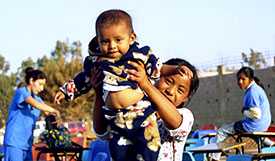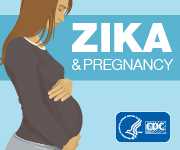
Smiling girl and baby enjoying a health outreach event in the Mexican border state of Baja California. Photo credit: Maureen Fonseca-Ford, CDC.
The United States and Mexico share a dynamic history of strong social and economic ties. This is especially true for the border region between the countries.
The United States and Mexico are connected by a high volume of travelers who cross the border. Travelers arrive by foot, car, and plane. In 2011 alone, 153,706,850 people crossed the land border between the United States and Mexico. 1 In addition, cargo shipments cross the border daily. This movement of people and cargo plays an important role in the health of communities in both countries.

Many people come and go from the United States and Mexico to live and work. As of 2010, nearly 11.7 million foreign-born residents from Mexico live in the United States, accounting for 29% of the 40 million foreign-born residents living in the United States. Among Mexican-born people worldwide, one in ten lives in the United States (2010).2
What health conditions are of concern for the United States and Mexico?
- Vaccine-preventable infectious diseases such as rubella and pertussis (whooping cough)
- Vector-borne diseases such as dengue and Rocky Mountain spotted fever, transmitted by mosquitoes, ticks, or fleas
- Zoonotic diseases spread from animals to human such as rabies and brucellosis
- Illnesses spread through food and water
- Tuberculosis
- HIV/AIDS
- Pandemic influenza and other global health emergencies
- Chronic health conditions
As a world leader in disease prevention and surveillance, CDC partners with health officials at the local, state, and binational levels to
- Protect the health of United States and Mexico residents.
- Improve and promote the health of travelers, migrants, and other mobile populations.
- Prevent the spread of infectious diseases across borders.
Zika Virus and Mexico
What is CDC's role in the partnership between the United States and Mexico?
- Collaborates with state and local public health agencies from the United States, Mexico, and other countries in the North American region.
- Coordinates and participates in infectious disease preparedness and response activities at international land and air ports-of-entry to the United States.
- Conducts border and binational infectious disease surveillance and outbreak investigations.
Unaccompanied Children at the Border
CDC understands that people may have concerns about issues related to unaccompanied children from Central America who are crossing into the United States.
Feature Stories

Cross-Border Partnerships
Learn more about CDC's accomplishments in Building Binational Public Health Partnerships.

Strengthening Binational Health
Learn more about how the United States and Mexico have Strengthened Binational Health.
Resources for US-Mexico Public Health
- Page last reviewed: April 5, 2016
- Page last updated: April 5, 2016
- Content source:




 ShareCompartir
ShareCompartir